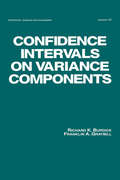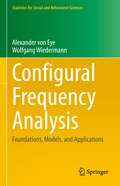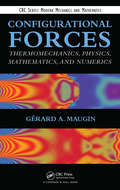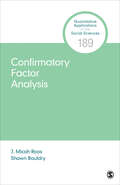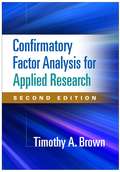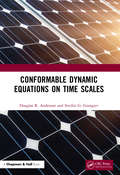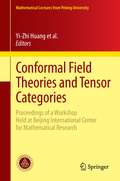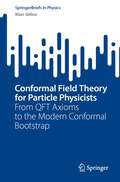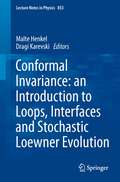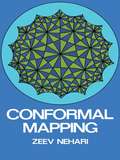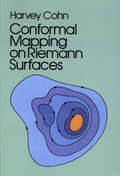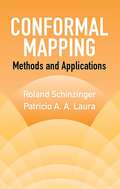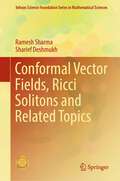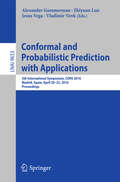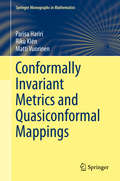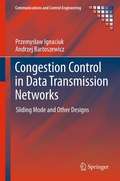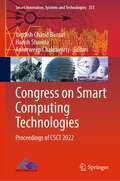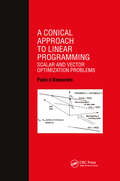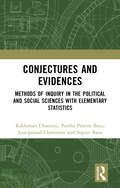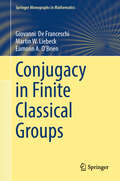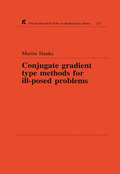- Table View
- List View
Confidence Intervals on Variance Components
by Richard K. Burdick Franklin A. GraybillSummarizes information scattered in the technical literature on a subject too new to be included in most textbooks, but which is of interest to statisticians, and those who use statistics in science and education, at an advanced undergraduate or higher level. Overviews recent research on constructin
Confidence, Likelihood, Probability
by Tore Schweder Nils Lid HjortThis lively book lays out a methodology of confidence distributions and puts them through their paces. Among other merits, they lead to optimal combinations of confidence from different sources of information, and they can make complex models amenable to objective and indeed prior-free analysis for less subjectively inclined statisticians. The generous mixture of theory, illustrations, applications and exercises is suitable for statisticians at all levels of experience, as well as for data-oriented scientists. Some confidence distributions are less dispersed than their competitors. This concept leads to a theory of risk functions and comparisons for distributions of confidence. Neyman–Pearson type theorems leading to optimal confidence are developed and richly illustrated. Exact and optimal confidence distribution is the gold standard for inferred epistemic distributions. Confidence distributions and likelihood functions are intertwined, allowing prior distributions to be made part of the likelihood. Meta-analysis in likelihood terms is developed and taken beyond traditional methods, suiting it in particular to combining information across diverse data sources.
Configural Frequency Analysis: Foundations, Models, and Applications (Statistics for Social and Behavioral Sciences)
by Wolfgang Wiedermann Alexander von EyeThis unique book provides a comprehensive and detailed coverage of configural frequency analysis (CFA), the most useful method of analysis of categorical data in person-oriented research. It presents the foundations, methods, and models of CFA and features numerous empirical data examples from a range of disciplines that can be reproduced by the readers. It also addresses computer applications, including relevant R packages and modules.Configural frequency analysis is a statistical method that allows the processing of important and interesting questions in categorical data. The perspective of CFA differs from the usual perspective of relations among variables; its focus is on patterns of variable categories that stand out with respect to specific hypotheses, and as such, CFA allows for testing numerous substantive hypotheses.The book describes the origins of CFA and their relation to chi-square analysis as well as the developments that are based on log-linear modeling. The models covered range from simple models of variable independence to complex models that are needed when causal hypotheses are tested. Empirical data examples are provided for each model. New models are introduced for person-oriented mediation analysis and locally optimized time series analysis, and new results concerning the characteristics of CFA methods are bolstered using Monte Carlo simulations.Primarily intended for researchers and students in the social and behavioral sciences, the book will also appeal to anyone who deals with categorical data from a person-centered perspective.
Configurational Forces: Thermomechanics, Physics, Mathematics, and Numerics (Modern Mechanics and Mathematics)
by Gerard A. MauginExploring recent developments in continuum mechanics, Configurational Forces: Thermomechanics, Physics, Mathematics, and Numerics presents the general framework for configurational forces. It also covers a range of applications in engineering and condensed matter physics. The author presents the fundamentals of accepted standard continuum mechanics
Confirmatory Factor Analysis (Quantitative Applications in the Social Sciences)
by J. Micah Roos Shawn BauldryMeasurement connects theoretical concepts to what is observable in the empirical world, and is fundamental to all social and behavioral research. In this volume, J. Micah Roos and Shawn Bauldry introduce a popular approach to measurement: Confirmatory Factor Analysis (CFA). As the authors explain, CFA is a theoretically informed statistical framework for linking multiple observed variables to latent variables that are not directly measurable. The authors begin by defining terms, introducing notation, and illustrating a wide variety of measurement models with different relationships between latent and observed variables. They proceed to a thorough treatment of model estimation, followed by a discussion of model fit. Most of the volume focuses on measures that approximate continuous variables, but the authors also devote a chapter to categorical indicators. Each chapter develops a different example (sometimes two) covering topics as diverse as racist attitudes, theological conservatism, leadership qualities, psychological distress, self-efficacy, beliefs about democracy, and Christian nationalism drawn mainly from national surveys. Data to replicate the examples are available on a companion website, along with code for R, Stata, and Mplus.
Confirmatory Factor Analysis (Quantitative Applications in the Social Sciences)
by J. Micah Roos Shawn BauldryMeasurement connects theoretical concepts to what is observable in the empirical world, and is fundamental to all social and behavioral research. In this volume, J. Micah Roos and Shawn Bauldry introduce a popular approach to measurement: Confirmatory Factor Analysis (CFA). As the authors explain, CFA is a theoretically informed statistical framework for linking multiple observed variables to latent variables that are not directly measurable. The authors begin by defining terms, introducing notation, and illustrating a wide variety of measurement models with different relationships between latent and observed variables. They proceed to a thorough treatment of model estimation, followed by a discussion of model fit. Most of the volume focuses on measures that approximate continuous variables, but the authors also devote a chapter to categorical indicators. Each chapter develops a different example (sometimes two) covering topics as diverse as racist attitudes, theological conservatism, leadership qualities, psychological distress, self-efficacy, beliefs about democracy, and Christian nationalism drawn mainly from national surveys. Data to replicate the examples are available on a companion website, along with code for R, Stata, and Mplus.
Confirmatory Factor Analysis For Applied Research (Methodology In The Social Sciences)
by Timothy A. BrownWith its emphasis on practical and conceptual aspects, rather than mathematics or formulas, this accessible book has established itself as the go-to resource on confirmatory factor analysis (CFA). Detailed, worked-through examples drawn from psychology, management, and sociology studies illustrate the procedures, pitfalls, and extensions of CFA methodology. The text shows how to formulate, program, and interpret CFA models using popular latent variable software packages (LISREL, Mplus, EQS, SAS/CALIS); understand the similarities and differences between CFA and exploratory factor analysis (EFA); and report results from a CFA study. It is filled with useful advice and tables that outline the procedures. The companion website (www.guilford.com/brown3-materials) offers data and program syntax files for most of the research examples, as well as links to CFA-related resources. New to This Edition *Updated throughout to incorporate important developments in latent variable modeling. *Chapter on Bayesian CFA and multilevel measurement models. *Addresses new topics (with examples): exploratory structural equation modeling, bifactor analysis, measurement invariance evaluation with categorical indicators, and a new method for scaling latent variables. *Utilizes the latest versions of major latent variable software packages.
Conformable Dynamic Equations on Time Scales
by Douglas R. Anderson Svetlin G. GeorgievThe concept of derivatives of non-integer order, known as fractional derivatives, first appeared in the letter between L’Hopital and Leibniz in which the question of a half-order derivative was posed. Since then, many formulations of fractional derivatives have appeared. Recently, a new definition of fractional derivative, called the "fractional conformable derivative," has been introduced. This new fractional derivative is compatible with the classical derivative and it has attracted attention in areas as diverse as mechanics, electronics, and anomalous diffusion. Conformable Dynamic Equations on Time Scales is devoted to the qualitative theory of conformable dynamic equations on time scales. This book summarizes the most recent contributions in this area, and vastly expands on them to conceive of a comprehensive theory developed exclusively for this book. Except for a few sections in Chapter 1, the results here are presented for the first time. As a result, the book is intended for researchers who work on dynamic calculus on time scales and its applications. Features Can be used as a textbook at the graduate level as well as a reference book for several disciplines Suitable for an audience of specialists such as mathematicians, physicists, engineers, and biologists Contains a new definition of fractional derivative About the Authors Douglas R. Anderson is professor and chair of the mathematics department at Concordia College, Moorhead. His research areas of interest include dynamic equations on time scales and Ulam-type stability of difference and dynamic equations. He is also active in investigating the existence of solutions for boundary value problems. Svetlin G. Georgiev is currently professor at Sorbonne University, Paris, France and works in various areas of mathematics. He currently focuses on harmonic analysis, partial differential equations, ordinary differential equations, Clifford and quaternion analysis, dynamic calculus on time scales, and integral equations.
Conformal Field Theories and Tensor Categories: Proceedings of a Workshop Held at Beijing International Center for Mathematical Research (Mathematical Lectures from Peking University)
by Chengming Bai Jürgen Fuchs Yi-Zhi Huang Liang Kong Ingo Runkel Christoph SchweigertThe present volume is a collection of seven papers that are either based on the talks presented at the workshop "Conformal field theories and tensor categories" held June 13 to June 17, 2011 at the Beijing International Center for Mathematical Research, Peking University, or are extensions of the material presented in the talks at the workshop. These papers present new developments beyond rational conformal field theories and modular tensor categories and new applications in mathematics and physics. The topics covered include tensor categories from representation categories of Hopf algebras, applications of conformal field theories and tensor categories to topological phases and gapped systems, logarithmic conformal field theories and the corresponding non-semisimple tensor categories, and new developments in the representation theory of vertex operator algebras. Some of the papers contain detailed introductory material that is helpful for graduate students and researchers looking for an introduction to these research directions. The papers also discuss exciting recent developments in the area of conformal field theories, tensor categories and their applications and will be extremely useful for researchers working in these areas.
Conformal Field Theory for Particle Physicists: From QFT Axioms to the Modern Conformal Bootstrap (SpringerBriefs in Physics)
by Marc GilliozThis book is a set of introductory lecture notes on Conformal Field Theory (CFT). Unlike most existing reviews on the subject, CFT is presented here from the perspective of a unitary quantum field theory in Minkowski space-time. The book starts with a non-perturbative formulation of quantum field theory (Wightman axioms) and then, gradually, focuses on the implications of scale and special conformal symmetry, all the way to the modern conformal bootstrap. This approach includes topics such as subtleties of conformal transformations in Minkowski space-time, the construction of Wightman functions and time-ordered correlators both in position- and momentum-space, unitarity bounds derived from the spectral representation, and the appearance of UV and IR divergences. In each chapter, the reader finds useful exercises to master the subject. This book is meant for graduate students in theoretical physics and for more advanced researchers working in high-energy physics who are not necessarily familiar with the concepts of conformal field theory. Prior knowledge of quantum field theory is needed to master the arguments.
Conformal Field Theory, Automorphic Forms and Related Topics: CFT, Heidelberg, September 19-23, 2011 (Contributions in Mathematical and Computational Sciences #8)
by Winfried Kohnen Rainer WeissauerThis book, part of the series Contributions in Mathematical and Computational Sciences, reviews recent developments in the theory of vertex operator algebras (VOAs) and their applications to mathematics and physics. The mathematical theory of VOAs originated from the famous monstrous moonshine conjectures of J. H. Conway and S. P. Norton, which predicted a deep relationship between the characters of the largest simple finite sporadic group, the Monster and the theory of modular forms inspired by the observations of J. MacKay and J. Thompson. The contributions are based on lectures delivered at the 2011 conference on Conformal Field Theory, Automorphic Forms and Related Topics, organized by the editors as part of a special program offered at Heidelberg University that summer under the sponsorship of the Mathematics Center Heidelberg (MATCH).
Conformal Geometry: Computational Algorithms And Engineering Applications (Advanced Lectures In Mathematics Ser.)
by Ying He Miao Jin Xianfeng Gu Yalin WangThis book offers an essential overview of computational conformal geometry applied to fundamental problems in specific engineering fields. It introduces readers to conformal geometry theory and discusses implementation issues from an engineering perspective.The respective chapters explore fundamental problems in specific fields of application, and detail how computational conformal geometric methods can be used to solve them in a theoretically elegant and computationally efficient way. The fields covered include computer graphics, computer vision, geometric modeling, medical imaging, and wireless sensor networks. Each chapter concludes with a summary of the material covered and suggestions for further reading, and numerous illustrations and computational algorithms complement the text.The book draws on courses given by the authors at the University of Louisiana at Lafayette, the State University of New York at Stony Brook, and Tsinghua University, and will be of interest to senior undergraduates, graduates and researchers in computer science, applied mathematics, and engineering.
Conformal Invariance: An Introduction To Loops, Interfaces And Stochastic Loewner Evolution (Lecture Notes in Physics #853)
by Dragi Karevski Malte HenkelConformal invariance has been a spectacularly successful tool in advancing our understanding of the two-dimensional phase transitions found in classical systems at equilibrium. This volume sharpens our picture of the applications of conformal invariance, introducing non-local observables such as loops and interfaces before explaining how they arise in specific physical contexts. It then shows how to use conformal invariance to determine their properties. Moving on to cover key conceptual developments in conformal invariance, the book devotes much of its space to stochastic Loewner evolution (SLE), detailing SLE's conceptual foundations as well as extensive numerical tests. The chapters then elucidate SLE's use in geometric phase transitions such as percolation or polymer systems, paying particular attention to surface effects. As clear and accessible as it is authoritative, this publication is as suitable for non-specialist readers and graduate students alike.
Conformal Mapping (Dover Books on Mathematics)
by Zeev NehariConformal mapping is a field in which pure and applied mathematics are both involved. This book tries to bridge the gulf that many times divides these two disciplines by combining the theoretical and practical approaches to the subject. It will interest the pure mathematician, engineer, physicist, and applied mathematician.The potential theory and complex function theory necessary for a full treatment of conformal mapping are developed in the first four chapters, so the reader needs no other text on complex variables. These chapters cover harmonic functions, analytic functions, the complex integral calculus, and families of analytic functions. Included here are discussions of Green's formula, the Poisson formula, the Cauchy-Riemann equations, Cauchy's theorem, the Laurent series, and the Residue theorem. The final three chapters consider in detail conformal mapping of simply-connected domains, mapping properties of special functions, and conformal mapping of multiply-connected domains. The coverage here includes such topics as the Schwarz lemma, the Riemann mapping theorem, the Schwarz-Christoffel formula, univalent functions, the kernel function, elliptic functions, univalent functions, the kernel function, elliptic functions, the Schwarzian s-functions, canonical domains, and bounded functions. There are many problems and exercises, making the book useful for both self-study and classroom use.The author, former professor of mathematics at Carnegie-Mellon University, has designed the book as a semester's introduction to functions of a complex variable followed by a one-year graduate course in conformal mapping. The material is presented simply and clearly, and the only prerequisite is a good working knowledge of advanced calculus.
Conformal Mapping on Riemann Surfaces (Dover Books on Mathematics)
by Harvey CohnThe subject matter loosely called "Riemann surface theory" has been the starting point for the development of topology, functional analysis, modern algebra, and any one of a dozen recent branches of mathematics; it is one of the most valuable bodies of knowledge within mathematics for a student to learn.Professor Cohn's lucid and insightful book presents an ideal coverage of the subject in five parts. Part I is a review of complex analysis analytic behavior, the Riemann sphere, geometric constructions, and presents (as a review) a microcosm of the course. The Riemann manifold is introduced in Part II and is examined in terms of intuitive physical and topological technique in Part III. In Part IV the author shows how to define real functions on manifolds analogously with the algebraic and analytic points of view outlined here. The exposition returns in Part V to the use of a single complex variable z. As the text is richly endowed with problem material -- 344 exercises -- the book is perfect for self-study as well as classroom use.Harvey Cohn is well-known in the mathematics profession for his pedagogically superior texts, and the present book will be of great interest not only to pure and applied mathematicians, but also engineers and physicists. Dr. Cohn is currently Distinguished Professor of Mathematics at the City University of New York Graduate Center.
Conformal Mapping: Methods and Applications (Dover Books on Mathematics)
by Roland Schinzinger Patricio A. LauraBeginning with a brief survey of some basic mathematical concepts, this graduate-level text proceeds to discussions of a selection of mapping functions, numerical methods and mathematical models, nonplanar fields and nonuniform media, static fields in electricity and magnetism, and transmission lines and waveguides. Other topics include vibrating membranes and acoustics, transverse vibrations and buckling of plates, stresses and strains in an elastic medium, steady state heat conduction in doubly connected regions, transient heat transfer in isotropic and anisotropic media, and fluid flow. Revision of 1991 ed. 247 figures. 38 tables. Appendices.
Conformal Vector Fields, Ricci Solitons and Related Topics (Infosys Science Foundation Series)
by Ramesh Sharma Sharief DeshmukhThis book provides an up-to-date introduction to the theory of manifolds, submanifolds, semi-Riemannian geometry and warped product geometry, and their applications in geometry and physics. It then explores the properties of conformal vector fields and conformal transformations, including their fixed points, essentiality and the Lichnerowicz conjecture. Later chapters focus on the study of conformal vector fields on special Riemannian and Lorentzian manifolds, with a special emphasis on general relativistic spacetimes and the evolution of conformal vector fields in terms of initial data.The book also delves into the realm of Ricci flow and Ricci solitons, starting with motivations and basic results and moving on to more advanced topics within the framework of Riemannian geometry. The main emphasis of the book is on the interplay between conformal vector fields and Ricci solitons, and their applications in contact geometry. The book highlights the fact that Nil-solitons and Sol-solitons naturally arise in the study of Ricci solitons in contact geometry. Finally, the book gives a comprehensive overview of generalized quasi-Einstein structures and Yamabe solitons and their roles in contact geometry. It would serve as a valuable resource for graduate students and researchers in mathematics and physics as well as those interested in the intersection of geometry and physics.
Conformal and Probabilistic Prediction with Applications: 5th International Symposium, COPA 2016, Madrid, Spain, April 20-22, 2016, Proceedings (Lecture Notes in Computer Science #9653)
by Alexander Gammerman Zhiyuan Luo Jesús Vega Vladimir VovkThis book constitutes the refereed proceedings of the 5th InternationalSymposium on Conformal and Probabilistic Prediction with Applications, COPA2016, held in Madrid, Spain, in April 2016. The 14 revised fullpapers presented together with 1 invited paper were carefully reviewed andselected from 23 submissions and cover topics on theory of conformal prediction; applicationsof conformal prediction; and machine learning.
Conformally Invariant Metrics and Quasiconformal Mappings (Springer Monographs in Mathematics)
by Parisa Hariri Riku Klén Matti VuorinenThis book is an introduction to the theory of quasiconformal and quasiregular mappings in the euclidean n-dimensional space, (where n is greater than 2). There are many ways to develop this theory as the literature shows. The authors' approach is based on the use of metrics, in particular conformally invariant metrics, which will have a key role throughout the whole book. The intended readership consists of mathematicians from beginning graduate students to researchers. The prerequisite requirements are modest: only some familiarity with basic ideas of real and complex analysis is expected.
Congestion Control in Data Transmission Networks: Sliding Mode and Other Designs (Communications and Control Engineering)
by Andrzej Bartoszewicz Przemysław IgnaciukCongestion Control in Data Transmission Networks details the modeling and control of data traffic in communication networks. It shows how various networking phenomena can be represented in a consistent mathematical framework suitable for rigorous formal analysis. The monograph differentiates between fluid-flow continuous-time traffic models, discrete-time processes with constant sampling rates, and sampled-data systems with variable discretization periods. The authors address a number of difficult real-life problems, such as: optimal control of flows with disparate, time-varying delay; the existence of source and channel nonlinearities; the balancing of quality of service and fairness requirements; and the incorporation of variable rate allocation policies. Appropriate control mechanisms which can handle congestion and guarantee high throughput in various traffic scenarios (with different networking phenomena being considered) are proposed. Systematic design procedures using sound control-theoretic foundations are adopted. Since robustness issues are of major concern in providing efficient data-flow regulation in today's networks, sliding-mode control is selected as the principal technique to be applied in creating the control solutions. The controller derivation is given extensive analytical treatment and is supported with numerous realistic simulations. A comparison with existing solutions is also provided. The concepts applied are discussed in a number of illustrative examples, and supported by many figures, tables, and graphs walking the reader through the ideas and introducing their relevance in real networks. Academic researchers and graduate students working in computer networks and telecommunications and in control (especially time-delay systems and discrete-time optimal and sliding-mode control) will find this text a valuable assistance in ensuring smooth data-flow within communications networks.
Congress on Smart Computing Technologies: Proceedings of CSCT 2022 (Smart Innovation, Systems and Technologies #351)
by Jagdish Chand Bansal Harish Sharma Antorweep ChakravortyThis book presents high-quality research papers presented at Congress on Smart Computing Technologies (CSCT 2022) organized by SAU Center for Research and Innovative Learning (SCRIL), South Asian University, India, from 3–4 December 2022. The book extensively covers recent research in algorithms for smart computing, AI and machine learning in smart computing, edge computing algorithms, adversarial networks and autoencoders, data visualization, data mining, data analytics, machine learning, game theory, high-performance computing, mobile and ubiquitous platforms for smart environments, cloud/edge/fog computing technologies for smart systems, Internet of Things (IoT) and industrial IoT technologies for smart systems, smart device and hardware, security, privacy, and economics in smart environments, big data, healthcare informatics, smart precision agriculture, smart transportation, social network analysis, and human–computer interaction.
Conical Approach to Linear Programming
by P D'AlessandroThe conical approach provides a geometrical understanding of optimization and is a powerful research tool and useful problem-solving technique (for example, in decision support and real time control applications). Conical optimality conditions are first stated in a very general optimization framework, and then applied to linear programming. A complete theory along with primal and dual algorithms is given, and solutions and algorithms are also provided for vector and robust linear optimization. The advantages of parameter dependence of conical methods are fully discussed. In addition to numerical results, the book provides source codes and detailed documentation of a Modula-2 implementation for the main algorithms.
Conjectures and Evidences: Methods of Inquiry in the Political and Social Sciences with Elementary Statistics
by Rakhahari Chatterji Partha Pratim Basu Jyotiprasad Chatterjee Suprio BasuThis book examines some of the major and most commonly used methods and statistics necessary for social science research. It is meant primarily for the beginners, and hence does not require any prior training in research methodology or statistics. The methods discussed include aggregate data analysis, the method of survey research, experimental and quasi-experimental research designs, participant observation, content analysis, and focus groups study. In a separate chapter the issue of quantitative and qualitative research methods and their uses has been discussed. An attempt has been made to assess these methods especially from the point of view of their adoption and application by social scientists working in the developing economies. Print edition not for sale in South Asia (India, Sri Lanka, Nepal, Bangladesh, Pakistan or Bhutan)
Conjugacy in Finite Classical Groups (Springer Monographs in Mathematics)
by Martin W. Liebeck Eamonn A. O'Brien Giovanni De FranceschiThis book provides a comprehensive coverage of the theory of conjugacy in finite classical groups. Given such a classical group G, the three fundamental problems considered are the following: to list a representative for each conjugacy class of G; to describe the centralizer of each representative, by giving its group structure and a generating set; and to solve the conjugacy problem in G—namely, given two elements of G, establish whether they are conjugate, and if so, find a conjugating element. The book presents comprehensive theoretical solutions to all three problems, and uses these solutions to formulate practical algorithms. In parallel to the theoretical work, implementations of these algorithms have been developed in Magma. These form a critical component of various general algorithms in computational group theory—for example, computing character tables and solving conjugacy problems in arbitrary finite groups.
Conjugate Gradient Type Methods for Ill-Posed Problems (Chapman And Hall/crc Research Notes In Mathematics Ser. #327)
by Martin HankeThe conjugate gradient method is a powerful tool for the iterative solution of self-adjoint operator equations in Hilbert space.This volume summarizes and extends the developments of the past decade concerning the applicability of the conjugate gradient method (and some of its variants) to ill posed problems and their regularization. Such problems occur in applications from almost all natural and technical sciences, including astronomical and geophysical imaging, signal analysis, computerized tomography, inverse heat transfer problems, and many moreThis Research Note presents a unifying analysis of an entire family of conjugate gradient type methods. Most of the results are as yet unpublished, or obscured in the Russian literature. Beginning with the original results by Nemirovskii and others for minimal residual type methods, equally sharp convergence results are then derived with a different technique for the classical Hestenes-Stiefel algorithm. In the final chapter some of these results are extended to selfadjoint indefinite operator equations.The main tool for the analysis is the connection of conjugate gradient type methods to real orthogonal polynomials, and elementary properties of these polynomials. These prerequisites are provided in a first chapter. Applications to image reconstruction and inverse heat transfer problems are pointed out, and exemplarily numerical results are shown for these applications.
